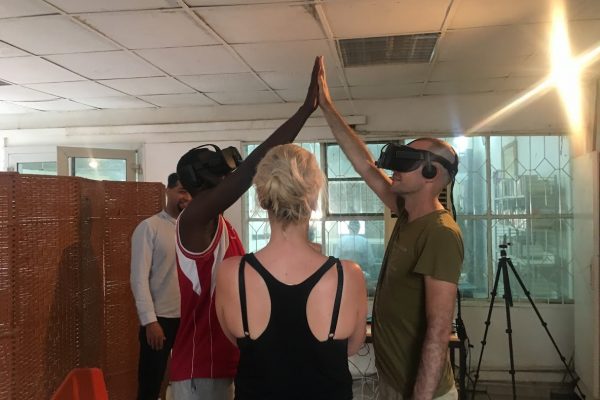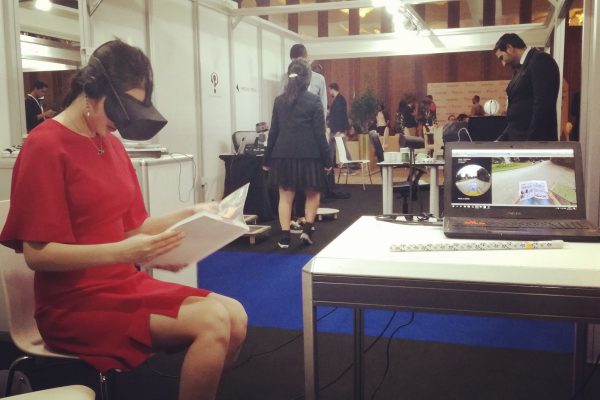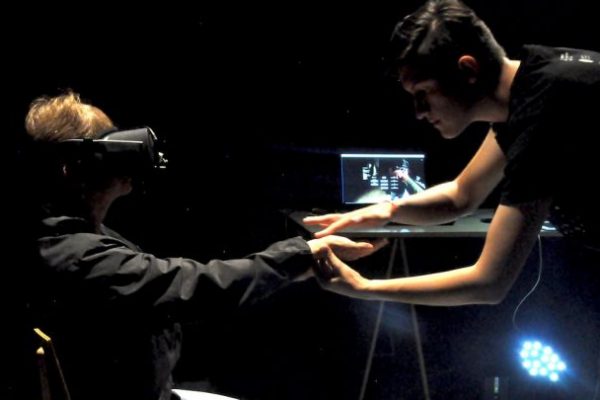The Machine To Be Another (TMBA) is an Embodiment Virtual Reality System (EVR) that credibly facilitates a body swap. This experience is called a Body Transfer Illusion in neuroscientific research laboratories. BeAnotherLab began its prototyping in 2012 in Barcelona to make this incredible experience available to the public.
The Machine allows individuals to experience the world through the eyes and body of another person. By combining virtual reality, cognitive sciences, and performance art, the system enables users to perceive themselves in a different body while moving and interacting with realistic tactile feedback with others in space.
The Machine is a unique system and our chief invention. It results from our long-term research on how to foster active perspective-taking and empathic concern.
Since 2014, we used The Machine to address issues of negative stereotyping. We engage with the art and film world interested in new technologies, subjectivities, perception, and storytelling. We collaborate with scientific researchers to learn more about the human sense of embodiment. We work with civil rights activists in applied contexts, where matters of immigration, mediation, and conflict resolution as well as care work, (therapeutic) body extension, and generational bonding, are of chief concern.
Year
2012 – now
Concepts
Embodiment. VR. Multicultural. Research. Understanding. Interdisciplinarity. Community. Inmersive. Tolerance. Innovation. People. Functional Diversity. Art. Neuroscience. Empathy.
Set ups
The Methodology
BeAnotherLab works at the intersection of art, science, and technology, questioning hierarchies between these different ways of knowing. We approach them as complementary, overlapping bodies of knowledge. Driven by an action-research approach, the Lab has developed a range of methodologies for interacting with individuals from communities that face different types of social prejudice, and on how to present this content to a general audience.
Empathic listening, for performers
We work with individuals and their communities interested in sharing a personal story or life experience. We begin by presenting our technology in hands-on workshops to mediate the intricacies of how The Machine system works. Gradually, we elicit how people would like to use The Machine for their benefit. This process consists of deep listening exercises, reflective conversations and the enactment of the system. Together we explore the potential participants see for the technology and how they would like to use it to address specific issues or to explore a topic of interest to them. Working through these questions, the social and affective context that emerges from this interaction is a central part of our methodology. In a process of co-design, we story-board and create new experiences together.
Debriefing, for users
Deep listening is not only an intrinsic part of the production but also of the exhibition of our work. When- and wherever TheMachine is presented, we suggest to include a debriefing area in the installation’s set up. This allows users to process their thoughts and feelings right after the VR experience, to talk to each other and to reflect on their emerging questions and ideas. When we present more sensitive content, our team will take part in this debrief.
Interdisciplinary collaborations
The Machine is a creative tool that encourages active and embodied perspective-taking. BeAnotherLab collaborates with people who find that technology useful for their own purposes, agendas and interests. Our expertise is rooted in the fluency with which we switch registers to enable interdisciplinary communication and mutual understanding. We have worked with neuroscientists, psychologists, physicians, therapists, technologists, engineers, human resources managers, grassroot organisers, artists and activists among many others. Our interdisciplinary collaborations have spanned across a wide range of subjectivities, postionalities, topics and issues. These working experiences continue to nurture the development of our project, while also allowing others to conduct their own research based on these explorations.






